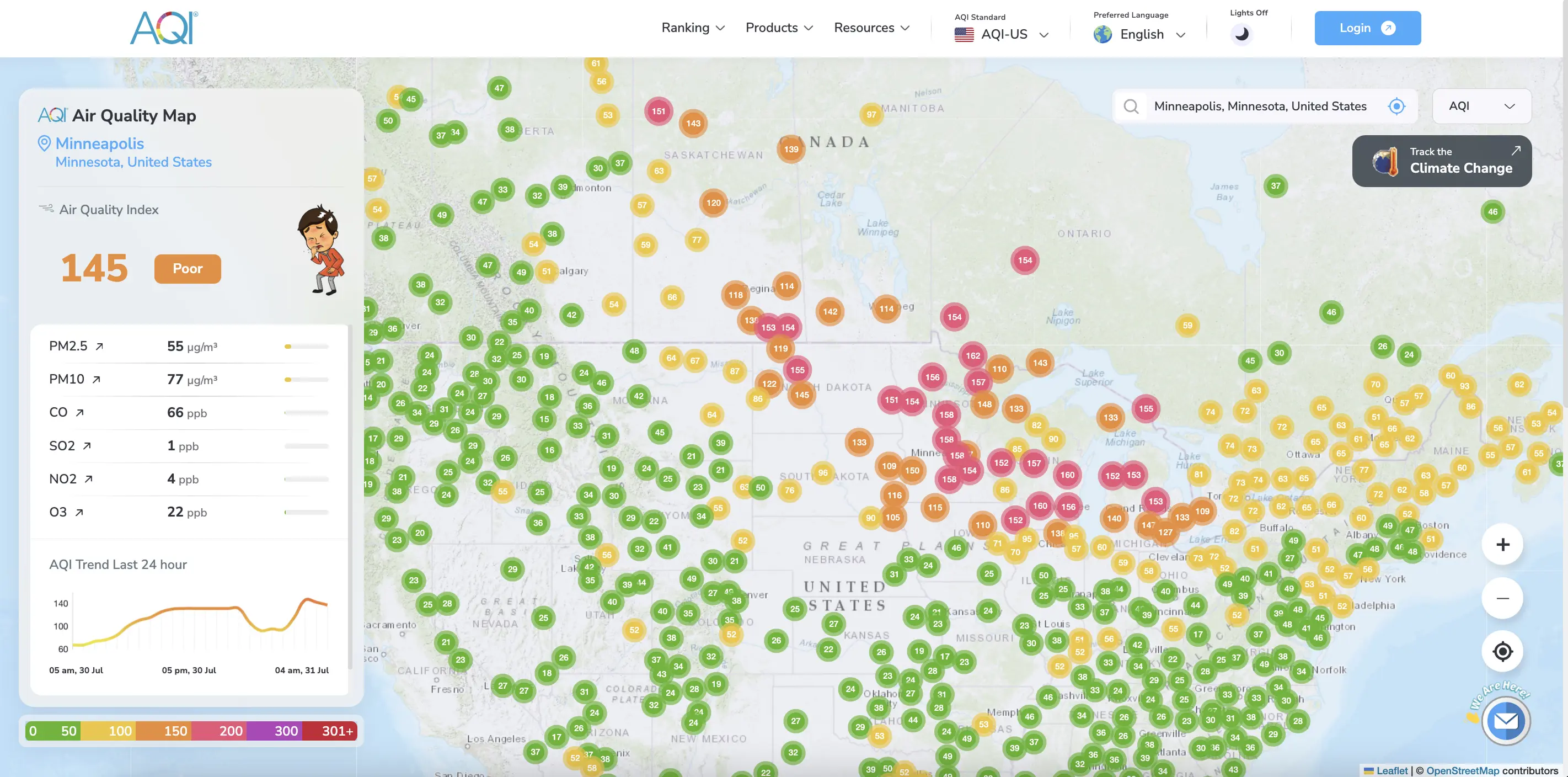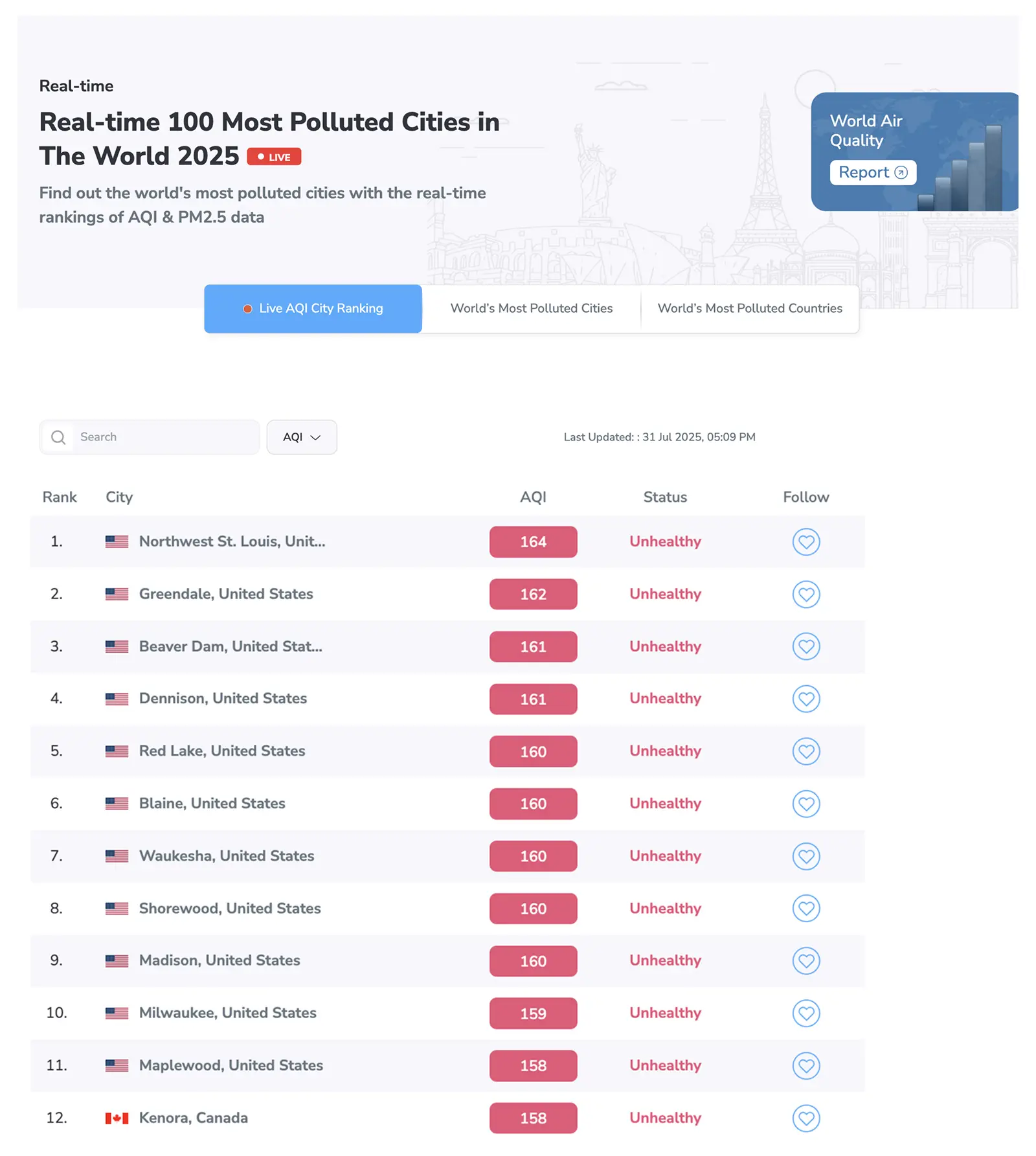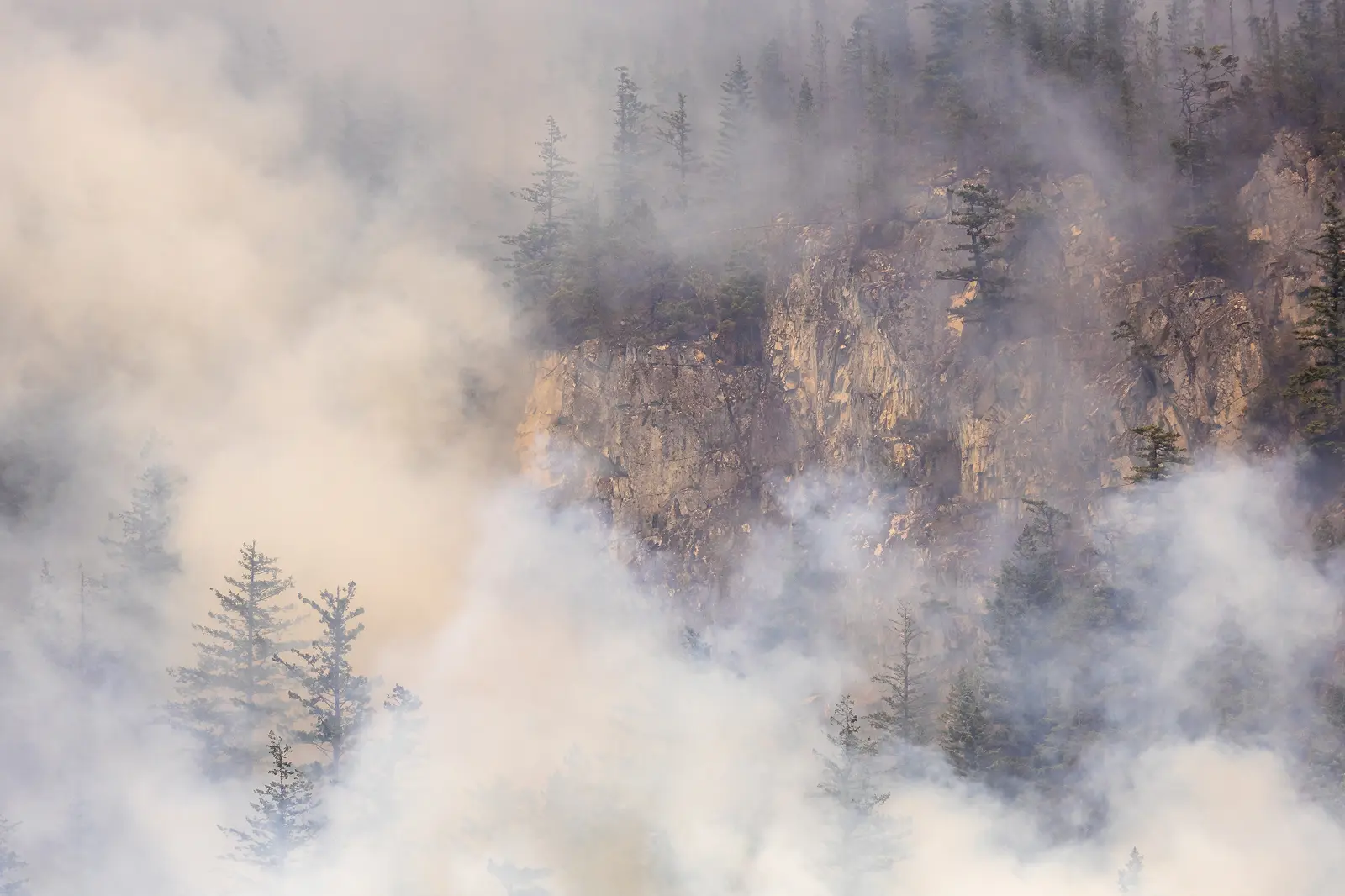The typically crisp and clean skies over Minneapolis took a sharp turn at the end of July 2025. Beginning July 29, smoke plumes from escalating wildfires in northern Canada and northern Minnesota drifted into the Twin Cities region, setting off a multi-day Minneapolis air quality alert with serious implications for public health.
This prolonged smoke intrusion followed the Minnesota Pollution Control Agency’s (MPCA) statewide expansion of air quality alerts starting July 23–25, as dense wildfire smoke advanced southward through Saskatchewan and Manitoba. By July 30, atmospheric shifts brought these pollutants straight into Minneapolis, triggering an official air quality alert that remains active through July 31 and beyond.
Wildfire Smoke Driving Pollution in Minneapolis, Causing Air Quality Alert
While no active wildfires were burning within the Minneapolis city limits at the time of the alert, the cause of the AQI spike was traced to smoke from regional fires. Wildfire activity in northern Minnesota, along with large-scale fires in Canada, sent dense smoke plumes into the Twin Cities region. Carried by shifting wind patterns, the smoke introduced large amounts of PM2.5 into the local air — the kind of pollution that is especially hazardous to the respiratory and cardiovascular systems.
Wildfire smoke is a growing environmental hazard across North America, and Minneapolis is no exception. Though often hundreds of miles from the source, cities like Minneapolis still experience severe air quality impacts as smoke travels across borders and lingers over urban areas.
Air Quality Alert in Minnesota’s Cities – Real-Time Air Pollution Levels

| City | Status | AQI | PM2.5 | PM10 |
| Minneapolis | Unhealthy | 160 | 68 | 79 |
| Red Lake | Unhealthy | 165 | 75 | 74 |
| Bemidji | Unhealthy | 164 | 73 | 75 |
| Northwest St. Louis | Unhealthy | 163 | 73 | 76 |
| Rochester | Unhealthy | 161 | 70 | 72 |
| St. Paul | Unhealthy | 151 | 56 | 68 |
| Mankato | Unhealthy | 162 | 71 | 72 |
| Maplewood | Unhealthy | 151 | 56 | 69 |
These figures reflect a statewide pollution emergency. Cities like Red Lake (AQI 165), Bemidji (164), and Northwest St. Louis (163) are experiencing even worse air quality than Minneapolis. The state as a whole is experiencing elevated PM2.5 concentrations, driven by the same weather and fire-related patterns affecting the Twin Cities.
Note: These are real-time readings from AQI.IN, recorded at 4:00 PM on July 31, 2025.
PM2.5 and Health Risks for Sensitive Groups
PM2.5 — or fine particulate matter with a diameter less than 2.5 microns — poses the most immediate threat during events like these. These microscopic particles can bypass natural respiratory filters and settle deep within the lungs, potentially entering the bloodstream. Long-term exposure to elevated PM2.5 levels has been linked to asthma, bronchitis, cardiovascular disease, and other chronic conditions.
People with preexisting respiratory or heart issues, children, older adults, and pregnant individuals are particularly vulnerable when AQI levels exceed 100. The reading of 147 in Minneapolis placed the air quality firmly into a category where sensitive groups are strongly advised to reduce prolonged or heavy outdoor activity.
Air Quality Deterioration Across the Midwest

Minneapolis is just one of several cities affected by this widespread pollution event. AQI rankings from July 31 show a troubling pattern across the Midwest. Several U.S. cities ranked among the most polluted globally that day, according to data from AQI.IN. Cities such as Northwest St. Louis (AQI 164), Greendale (162), Beaver Dam (161), and Red Lake (160) all reported “Unhealthy” air quality levels. Other major metro areas like Milwaukee, Madison, and Maplewood also recorded AQI values well above 150.
These figures reflect a growing regional issue, where wildfire smoke is not just a local hazard but a shared air quality crisis affecting states across the northern tier of the U.S.
A Pattern, Not a One-Off Event
The recent AQI spike in Minneapolis may have lasted only 24 to 48 hours, but such incidents are becoming more common — and more intense. Wildfire smoke events have increased in frequency due to changing climate patterns that contribute to hotter, drier summers and longer fire seasons. What once might have been considered rare has now become a recurring concern in areas that historically had clean air.

For Minneapolis, this means preparing for more air quality alerts, potentially for longer periods each year. The increase in high-AQI days is not just an environmental issue, but a public health warning that demands long-term planning and infrastructure response.
How to Stay Safe During Air Quality Alerts in Minneapolis?
Public health authorities in Minnesota recommend several steps for protecting yourself when air quality worsens. These include staying indoors with windows and doors closed, using HEPA-filtered air purifiers, setting HVAC systems to recirculate air, and avoiding physical exertion outdoors.
When outdoor exposure is necessary, especially in areas with AQI over 100, the use of N95 or equivalent masks is strongly encouraged. These can help filter out dangerous particles and reduce inhalation of pollutants. Sensitive individuals should also follow medical advice regarding medication and exposure limitations.
Monitoring Air Quality with Reliable Data
Real-time data from platforms like AQI.IN and Governmental platforms are critical for public awareness. Residents are encouraged to monitor local air quality conditions, particularly during wildfire season, and adjust daily routines accordingly.
Regularly check the hourly updates, pollutant breakdowns, and historical trends — all of which can help individuals and families make informed decisions about when to stay inside, what precautions to take, and how long to limit exposure.
Looking Ahead: What Minneapolis Can Expect?
While conditions may improve in the days ahead due to potential weather changes, the long-term outlook remains uncertain. As wildfires continue to affect regions far beyond their origin points, cities like Minneapolis must prepare for recurring air quality challenges each summer.
This means more public alerts, greater reliance on air quality forecasting tools, and deeper collaboration between environmental agencies and urban health planners. The recent AQI spike is a warning, but also an opportunity to invest in air-quality resilience — not just for the most vulnerable, but for the entire community.